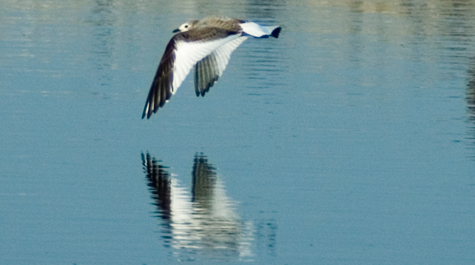Sandy blows in rare birds (and brings out the birders)
Now’s the time for birders who want to add to their life lists, says Dan Cristol, an ornithologist at William & Mary.
The “frankenstorm” that hit the eastern U.S. brought out birders even before Sandy’s winds died down, he said. East Coast birders converged on the Philadelphia area: the day after Sandy passed, birders were able to add eight new species to the list of birds spotted within the Philly city limits. The post-storm birders logged surf scoter, black scoter, Leach’s storm-petrel, red phalarope, Sabine’s gull, sooty tern, royal tern and parasitic jaeger—species who usually either live in the tropics and/or stay far out to sea, Cristol said.
The sheer size of the Sandy event could even have carried seabirds far, far inland, he added.
“The Great Lakes may be full of seabirds; I don’t know,” Cristol said. He explained that hurricanes and other large weather events often displace birds far from their homes, creating temporary sighting opportunities.
“We used to think birds were just getting killed by these storms, but actually they get up in the northeast quadrant and just ride it out,” Cristol explained. “When the storm hits land, they go down into lakes and bays.”
He suggested that birders wanting to spot displaced species—especially seabirds—should follow the example of the Philadelphia birders and stake out the mouths of rivers and bays. For inland birders, lakes and reservoirs are good bets for post-storm birding, he added. Cristol, a professor in William & Mary’s biology department, is the co-founder of the Institute for Integrative Bird Behavior Studies at William & Mary and writes a regular birders’ column for the Virginia Gazette.
Sandy’s passing isn’t all good news on the ornithological front, though. “Good news for birders is often bad news for birds,” Cristol noted.
“This is a very bad event for any saltwater wetland bird, like rails, sandpipers and some species of sparrows,” Cristol said. “When a storm hits, they just have no place to go. Typically they have high-water roosting places during the full moon, certain little hummocks where they all concentrate, and a storm like Sandy puts all those places under water—sometimes permanently.”
He said that these species often are not particularly strong fliers and some shelter-seeking wetland birds climb up on roads and even into the yards of nearby homes.
“You will see probably thousands of dead rails washing up on the beaches of the East Coast after this. They just have no place to go,” Cristol said. “Wetland birds get a double whammy. First they get killed by the storm, then those wetlands are destroyed.”
On a more positive note, Sandy occurred late enough in the season that the storm is unlikely to have any detrimental effect on the fall migration of songbirds. Cristol pointed out that this year’s migration been especially good for some northern birds that don’t always migrate south.
“Evening grosbeaks, purple finches, pine siskins and red-breasted nuthatches have been inundating the Williamsburg area,” he said. “I noticed after the storm that they’re still around.”
 Skip to main content
Skip to main content

